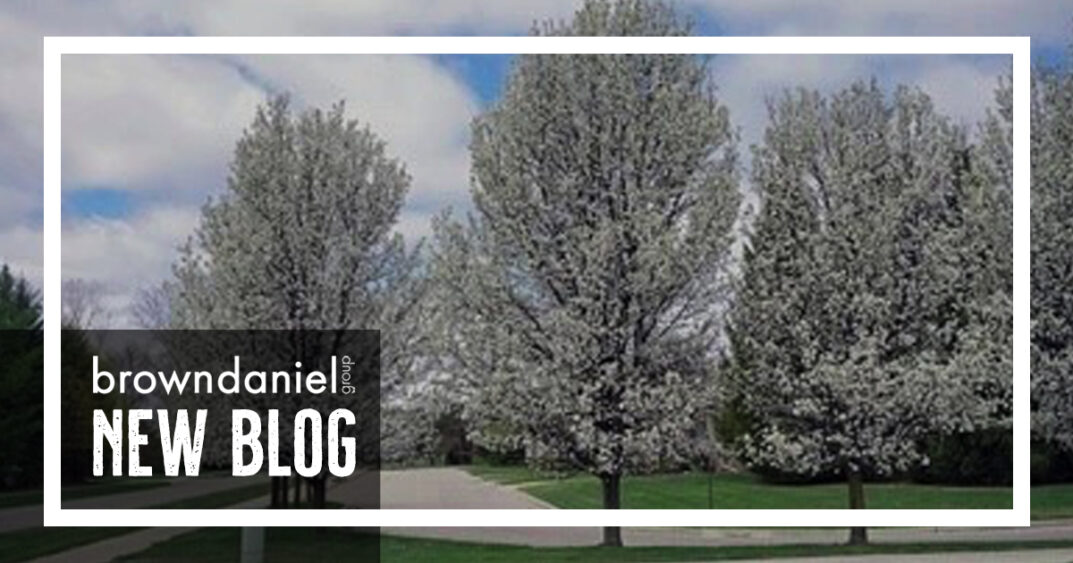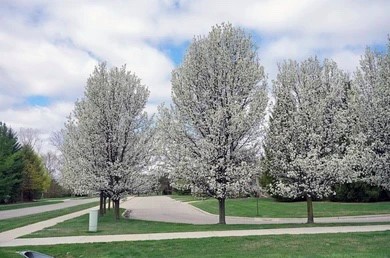
The front of your house and the property surrounding it is the first thing anyone will see when they arrive at your home, and will be how you give your first impression to friends, neighbors, and passersby. If you want to present an attractive and seamless curb appeal experience, the trees and shrubs that you plant in front of your home should guide guests to the entryway while helping your house blend in well with the natural landscape surrounding it. However, sometimes the trees and plants that you find attractive are not actually well suited for your home, climate or surroundings. Something that looks fantastic may actually be prone to certain pests or diseases, or may grow far too large for the area where it is planted. Here we have compiled a list of a few plants and trees we have to recommend against planting in your Atlanta area front yard.
Bradford Pear
Bradford Pears have been one of the top choices for trees in suburban Southern neighborhoods for decades. They are fast growing, easy to transplant and easy to maintain, making them the perfect choice for adding back greenery in a subdivision that was originally clear cut when built. In fact, when purchasing their homes, many people assume that the Bradford Pears they see were already in existence, and left untouched by the builders when ground was broken on their homes. These trees put on a vibrant show in the spring with their showy (and snowy) flowers, and they impress again in the fall with their spectacular red foliage.
Because of all of these reasons, it is no surprise that most homeowners love their Bradford Pear trees, so why don’t we recommend them? First, these trees are not very stable – main branches emerge from a common point on the trunk, making the tree weak and vulnerable to snapping in apart storms. Bradford Pears grow tall quickly, and often grow to be much bigger than people originally had in mind. For example, in just 20 years, a Bradford Pear tree can reach a height of 50 feet and can grow to 40 feet. Aside from size issues, Bradford Pears can also have a negative effect on your grass, because the tree’s surface roots and dense shade make it nearly impossible to grow grass beneath it. And those gorgeous white flowers? To many people, they smell more like fish than foliage and the odor is generally considered off-putting. Luckily there are several newer varieties of pear trees on the market that give your yard the look of a Bradford Pear without having as many drawbacks. Look for varieties like Chanticleer and Trinity, which are better choices for most suburban yards.
Golden Euonymus

Many people love the Golden Euonymus for hedging the front of their home. This evergreen shrub fills in spaces quickly and displays bold green and gold foliage. It is adaptable to almost any condition and tolerates poor soil and limited water and attention. You can let it grow as thick and tall as you like, but it also reacts well to regular pruning. All of this makes Golden Euonymus sound like a fantastic choice for residential shrubbery. Instead, we have to warn you against planting this particular shrub in front of your home.
Golden Euonymus is prone to mildew, which is only exacerbated by hot and humid conditions, the type of weather we see a lot of in metro Atlanta. While some people enjoy the subtle change from green to gold on the leaves, the colors are not uniformly distributed, and often make the plants look more like they are on death’s door than simply multi-colored. So even when your shrubs are not being damaged by the hot weather, they may look like they are suffering mightily. Golden Euonymus also attracts various insects and pests. They are prone to invasions by aphids, weevils and spider mites. Once attacked, the plants begin looking unhealthy almost immediately.
Leyland Cypress
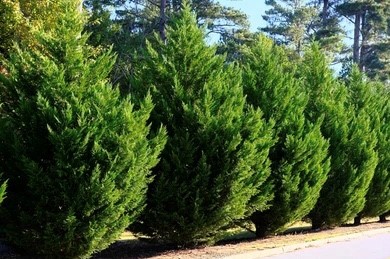
Very few people who plant a Leyland Cypress understand just how large the tree may grow. It is not uncommon for this evergreen to reach a height of more than 70 feet tall and, they can grow to over 15 feet wide. They also grow very fast – as much as three feet each year. All of this makes the Leyland Cypress an excellent choice if you are attempting to grow a natural privacy fence between your home and that of a neighbor, or as a way to line your property, especially if you live on a busy road or at the border of a subdivision. However, this also means that the Leyland Cypress is likely not a great choice as a solo tree planted in your front yard.
Recently in the South, the Leyland cypress has also come under widespread attack by a potentially fatal fungus called Seridium canker. This illness often causes the affected tree to gradually turn yellow and brown, and then eventually die from the top down. Times of drought increase stress on the trees and make them more vulnerable to this disease.
Privet
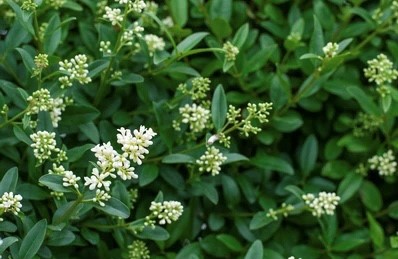
Various varieties of the privet plant came to the eastern United States from Japan and China in the mid-1800s, and since that time they have spread from Florida to Maryland, becoming one of the South’s favorite plants for both ornamental hedges and natural privacy fencing. However, since the plant is fast growing and has foreign origins, it is actually considered an invasive species, and can quickly overtake the area where it is planted, choking out other shrubs and flowers. During the spring, privet plants produce attractive white flowers, but these blooms cause severe reactions in people with allergies, and for many people their sickeningly sweet odor is a bit much. These flowers in turn give rise to hundreds of blueish black berries. Birds love these berries, and are the main culprit in spreading privet far and wide. These bushes also need a lot of trimming because of their fast growth rate, making them a labor intensive choice for your front yard.
The various types of privet are all also prone to disease and insect infestation, the worst of which is scales. White, reddish or brown bumps start on the stems and the undersides of leaves. These bumps are actually sap-sucking insects and they greatly weaken the plant. Privets are also prone to the leaf spot, in which irregularly shaped tan spots surrounded by a dark brown border appear on the leaves. Caused by a fungus, leaf spot is unattractive and spoils the look of your hedge.
Redtip Photinia
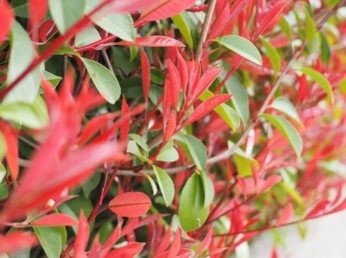
The Redtip Photinia is a popular shrub that is easily recognized around Southern homes, especially in the spring, when it’s bright red leaves first appears. This is a plant that grows well in almost any environment and in even the most stubborn soil as long as it is not over watered. This means that Redtip Photinia thrives in metro Atlanta’s hot and sometimes try springs and summers. Unfortunately, recent popularity has led to overplanting, so when this particular shrub species began to be hit with a leaf fungus, it caused dead spots in hedges far and wide. The flowers that appear on these plants mid-spring are an attractive white, but much like the Bradford Pear discussed previously, they have a foul smell that most people find to be unpleasant. Redtip Photinia is also susceptible to a disfiguring disease called Entomosporium leaf spot. When this illness hits the plant, small spots appear on young leave that gradually turn grayish with a dark purple border. Severely infected leaves drop prematurely from the plant.
Additional Tips
Whether you choose to plant any of the aforementioned plants, or a selection of more aesthetically pleasing trees and shrubs, here are some things to remember in order to keep your front yard looking fantastic:
Don’t Over Crowd Plants: Planting small shrubs close together may give you a mature and full look at first, but it reduces air circulation around leaves and stems, encouraging disease. Overcrowding also weakens plants by forcing them to compete for sunlight, water and nutrients from the soil.
Give the Right Amount of Water: Remember that you need to do your research ahead of time to know how much water each tree and shrub you plant needs. Overwatering can be just as detrimental as overwatering.
Protect the Bark: Bark is like skin to your plant. Accidentally wounding the bark of a shrub is similar to scraping or cutting your skin. It allows ready access for insects, fungi, bacteria and viruses, so be careful with your hedge trimmers.
Value Variety: Planting too many of the same plant close together is a recipe for front yard disaster. If you happen to fall victim to a plant-specific disease or pest outbreak, your entire curb appeal could be lost as all of the plants of one variety die out.

